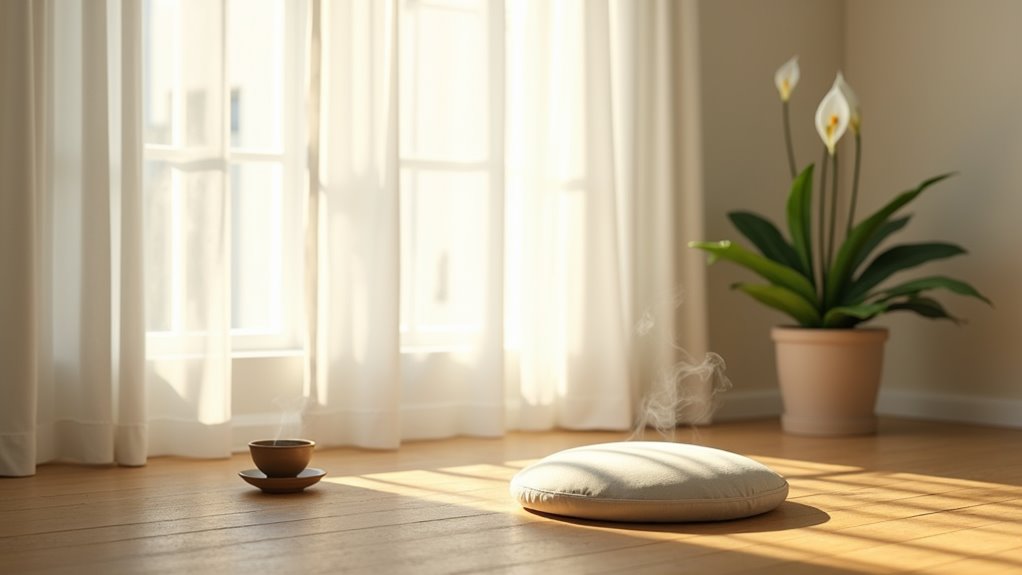Finding stillness in today's chaotic world isn't just a luxury – it's a biological necessity for your mental health and well-being. You'll discover that incorporating quiet rituals, mindful breathing techniques, and tech-free zones into your daily routine can significantly reduce stress and boost creativity. Nature offers an immediate sanctuary, where even brief moments outdoors can reconnect you with inner peace and lower cortisol levels. By practicing simple techniques like box breathing or mindful tea drinking, you'll create powerful anchors of calm. The path to serenity lies in understanding these essential practices and making them your own.
Key Takeaways
- Establish daily quiet rituals in a dedicated space to create moments of stillness and reset your nervous system naturally.
- Practice mindful breathing techniques like box breathing for 5-10 minutes to reduce stress and increase mental clarity.
- Incorporate regular nature breaks into your routine, using outdoor spaces as personal sanctuaries for psychological restoration.
- Create tech-free zones in your home to minimize digital distractions and promote deeper connections with yourself and others.
- Start with just five minutes of daily mindfulness practice, gradually increasing duration to build sustainable habits of inner peace.
Understanding Our Need for Stillness

Peace calls to us in a world that never stops moving. You feel it deep within – that yearning for quiet moments when your mind can finally rest. It's not just a want, but a fundamental need hardwired into your biological makeup.
Your brain requires stillness to process, heal, and restore itself. When you're constantly bombarded by notifications, deadlines, and endless tasks, your stress hormones surge, leaving you mentally and physically depleted. You'll notice your focus scatter, your patience thin, and your creativity diminish.
Finding stillness isn't about escaping reality – it's about creating space to breathe, think, and reconnect with yourself. By understanding this vital need, you can begin to prioritize moments of calm amid life's inevitable storms.
The Science Behind Inner Peace
Modern neuroscience reveals what ancient wisdom traditions have long known – inner peace isn't just a feeling, it's a measurable state in your brain.
When you're calm, your brain produces alpha waves, which reduce stress hormones like cortisol and increase feel-good chemicals like serotonin and dopamine.
Your prefrontal cortex, the brain's executive center, becomes more active during peaceful states, improving your decision-making and emotional regulation.
Meanwhile, your amygdala, the fear center, becomes less reactive. This shift creates a positive feedback loop: the calmer you become, the better your brain functions, and the easier it's to maintain that tranquility.
Research shows that regular meditation and mindfulness practices can actually change your brain's structure, increasing gray matter in areas associated with emotional stability and self-awareness.
Creating Daily Quiet Rituals

Building on our understanding of the brain's peaceful circuitry, you can develop simple daily rituals that foster inner calm. Start by designating specific times for quiet reflection – perhaps five minutes each morning before checking your phone or ten minutes after lunch.
Create a dedicated space where you won't be disturbed. You'll find that consistent practice yields the best results. Choose activities that resonate with you: deep breathing exercises, mindful tea drinking, or simply sitting in silence.
When you establish these moments as non-negotiable parts of your day, they become powerful anchors of tranquility. Keep your ritual simple and sustainable – you're more likely to maintain it. Even brief periods of intentional quiet can reset your nervous system and provide clarity amid life's demands.
Nature as Your Sanctuary
While technology surrounds us at every turn, nature offers an immediate pathway to tranquility that's both free and accessible. You'll find peace in the gentle rustling of leaves, the rhythmic sound of waves, or the warmth of sunshine on your skin.
These natural elements can instantly lower your stress levels and help you reconnect with your inner calm. Make it a point to step outside daily, even if it's just for ten minutes.
You can create your own sanctuary by finding a favorite spot in a local park, tending to a small garden, or simply sitting on your balcony watching birds. Nature's inherent patterns and cycles remind you to slow down and breathe.
When you're feeling overwhelmed, let the outdoors become your refuge.
Mindful Breathing Techniques

When you're feeling overwhelmed, you'll find powerful relief in three essential breathing techniques.
You can start with box breathing's simple four-count pattern, then explore the balancing effects of alternate nostril breathing for deeper relaxation.
Mindful breath counting offers you a straightforward way to anchor your attention and reset your nervous system during stressful moments.
Basic Box Breathing Pattern
Box breathing offers a simple yet powerful method to reduce stress and increase focus through controlled breathing. This four-step pattern follows a square's shape, with each phase lasting four seconds.
You'll start by inhaling slowly through your nose while counting to four. Hold this breath for another four seconds, feeling your lungs fully expanded.
Then exhale steadily through your mouth for four seconds, completely releasing the air. Finally, hold your empty lungs for four more seconds before starting the cycle again.
Practice this technique for at least four complete cycles to feel its calming effects. You can perform box breathing anywhere – at your desk, during your commute, or before an important meeting.
As you become more comfortable, you may extend each phase to five or six seconds.
Alternate Nostril Technique
As an ancient yogic practice, alternate nostril breathing brings balance to both mind and body through controlled breathing patterns.
You'll start by using your right thumb to close your right nostril while inhaling deeply through your left nostril. Then, close your left nostril with your ring finger, release your thumb, and exhale through your right nostril. Next, inhale through your right nostril, close it, and exhale through your left.
This rhythmic alternation helps balance the brain's hemispheres and calm your nervous system. You'll notice reduced anxiety, improved focus, and enhanced mental clarity after just a few minutes of practice.
For best results, find a quiet space and maintain an upright posture while practicing this technique for 5-10 minutes daily.
Mindful Breath Counting
Since ancient times, mindful breath counting has served as a foundational meditation practice to cultivate present-moment awareness.
You'll find this technique remarkably simple, yet profoundly effective at calming your mind and reducing stress.
To begin, sit comfortably and breathe naturally. Count "one" on your first exhale, "two" on the next, and continue until you reach "five." Then start over.
If you lose count or your mind wanders, gently return to "one." Don't judge yourself – mind-wandering is normal.
You can practice this technique anywhere, whether you're stuck in traffic or waiting in line.
As you build consistency, you'll notice improved focus and decreased anxiety. Try starting with three minutes daily, then gradually extend your sessions as you become more comfortable with the practice.
Digital Detox for Mental Clarity
You'll discover remarkable mental clarity by setting strict daily limits on your screen time and replacing endless scrolling with mindful moments in nature.
Creating tech-free zones in your bedroom and dining area helps establish healthy boundaries between digital life and personal space.
When you consciously swap social media apps for outdoor walks or garden time, you'll notice an immediate shift in your mood and focus.
Limit Screen Time Daily
While digital devices have become essential tools in modern life, excessive screen time can significantly impact your mental well-being and inner peace.
You'll find greater serenity by setting clear boundaries around your device usage.
Start by establishing screen-free zones in your home, particularly your bedroom and dining area. Set specific time blocks for checking emails and social media rather than responding to every notification.
Use apps that track and limit your daily screen time, helping you stay accountable to your goals.
Consider implementing a "sunset rule" – no screens two hours before bedtime. This practice will improve your sleep quality and create space for calming activities like reading or meditation.
You'll notice improved focus, reduced anxiety, and a stronger connection to the present moment when you consciously reduce your screen exposure.
Replace Apps With Nature
As technology continues to dominate our daily routines, spending time in nature offers a powerful antidote to digital overload.
You'll find that replacing your screen time with outdoor activities can reset your mind and restore your natural rhythms. Instead of checking social media, take a walk in a nearby park or tend to a small garden. Rather than streaming videos, watch the sunset or observe local wildlife. You can substitute your gaming sessions with hiking, rock collecting, or bird watching.
Even simple actions like feeling grass beneath your feet or listening to rustling leaves can help break your dependency on digital devices.
When you're surrounded by nature's beauty, you'll notice your stress levels drop and your creativity surge.
The outdoors provides endless opportunities for mindfulness and genuine connection that no app can replicate.
Create Tech-Free Zones
Establishing tech-free zones in your home creates essential sanctuaries for mental clarity and emotional well-being. Designate specific areas, like your bedroom or dining room, where devices aren't welcome. This boundary helps you disconnect from digital distractions and reconnect with yourself and loved ones.
Start by removing TVs, phones, and tablets from these spaces. Replace them with books, art supplies, or meditation cushions to encourage mindful activities. You'll find these tech-free havens become natural spots for deep conversations, restful sleep, and creative pursuits.
Make your morning and evening routines device-free by keeping phones out of arm's reach. This simple change can transform your wake-up and wind-down times into peaceful transitions, reducing anxiety and improving your sleep quality.
Building a Sustainable Peace Practice

Since finding inner peace requires consistent effort, developing a sustainable practice is essential for long-term success. You'll need to create habits that fit naturally into your daily routine rather than forcing dramatic lifestyle changes that won't last.
Start small by dedicating just five minutes each day to mindfulness or meditation. As this becomes comfortable, gradually increase the duration. Choose activities that resonate with your personality – whether it's morning journaling, evening walks, or midday breathing exercises. You'll find greater success by selecting practices you genuinely enjoy.
Track your progress using a simple app or notebook, noting how you feel before and after each session. This feedback will help you identify which techniques work best for you and motivate you to maintain your peace practice over time.
Frequently Asked Questions
Can Meditation Help With Chronic Physical Pain Conditions?
Like a dimmer switch gradually lowering the intensity of light, meditation can help reduce your perception of chronic pain.
When you practice mindfulness meditation regularly, you'll notice changes in how your brain processes pain signals. You'll learn to observe discomfort without getting caught up in it, and research shows this can decrease pain intensity.
Your body's stress response also calms down, which often lessens physical symptoms.
How Long Should I Practice Stillness Before Seeing Meaningful Results?
You'll notice initial benefits like reduced stress and improved focus within 1-2 weeks of daily practice, dedicating just 10-15 minutes per session.
However, meaningful transformation typically occurs after 8-12 weeks of consistent practice.
Don't focus on time expectations – everyone's journey differs.
What matters most is building a regular routine, even if you start with just 5 minutes daily and gradually increase your practice.
What if I Experience Anxiety or Panic During Quiet Meditation?
While it's normal to feel anxious during meditation, don't let that stop you.
Instead, acknowledge these feelings without judgment and gently return to your breath. You can try opening your eyes, focusing on a fixed point, or switching to walking meditation if sitting feels too intense.
Does Practicing Stillness Affect Productivity and Work Performance?
Regular stillness practice can significantly boost your productivity and work performance.
When you take time to quiet your mind, you'll find improved focus, clearer decision-making, and enhanced creative thinking.
You'll manage stress better, leading to fewer mistakes and more efficient task completion.
The mental clarity you gain helps you prioritize effectively and stay present during important work moments, ultimately making you more successful in your professional life.
Can Children Benefit From Stillness Practices, and at What Age Should They Start?
You can introduce children to stillness practices as early as age 3-4, starting with simple breathing exercises and brief quiet moments.
You'll find that kids benefit through improved focus, better emotional regulation, and reduced anxiety.
Keep sessions short – 1-2 minutes for young children, gradually increasing with age.
Make it playful by using engaging metaphors like "being a quiet tree" or "breathing like a sleeping lion."
Conclusion
You're part of the 75% of adults who report experiencing moderate to high stress daily. But by weaving moments of stillness into your life through mindful breathing, nature immersion, and digital boundaries, you'll discover a profound sense of peace that transforms how you move through the world. Start small, stay consistent, and watch as serenity becomes your natural state rather than a distant goal.

Leave a Reply